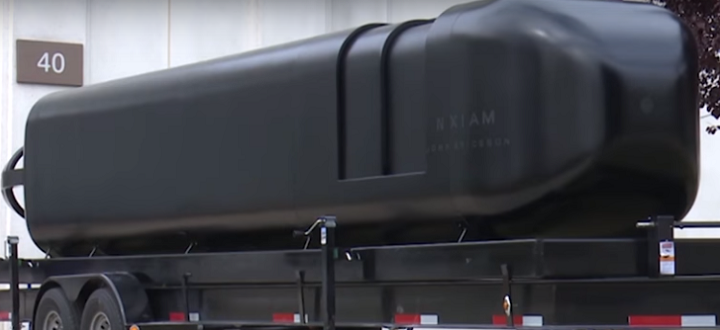 Underway replenishment, also known as replenishment at sea (RAS) is a method of transferring supplies from one ship to another while a naval mission is underway. In a paper entitled “Future UNREP: Existing Technologies, Concepts of Operation, and Why Replenishment at Sea Must Evolve,” the authors argue that the methods of underway replenishment need to advance, and that they have a lot of potential to do so thanks to technology such as additive manufacturing.
Underway replenishment, also known as replenishment at sea (RAS) is a method of transferring supplies from one ship to another while a naval mission is underway. In a paper entitled “Future UNREP: Existing Technologies, Concepts of Operation, and Why Replenishment at Sea Must Evolve,” the authors argue that the methods of underway replenishment need to advance, and that they have a lot of potential to do so thanks to technology such as additive manufacturing.
Additive manufacturing is described in the paper as “a technology with significant potential for both industry and the Department of Defense (DoD).” Regarding the US Navy, the promise of additive manufacturing lies greatly in its flexibility and its potential for personalized manufacturing. The paper cites a 2014 Deloitte study that highlights the technology’s ability to deliver the right part at the right place, the right time and in the right quantity. The value of additive manufacturing, the study continues, includes the ability to manufacture parts that are:
- Individually customized for specific purposes
- Produced at the actual point of use
- Created on demand
- Manufactured in lower quantities with no loss of design fidelity
Additive manufacturing has been largely accepted by the Navy; in 2015, then-Secretary of the Navy Ray Mabus issued a memorandum to the Chief of Naval Operations, Commandant of the Marine Corps, and the Assistant Secretary of the Navy (Research, Development and Acquisition) to further develop and implement additive manufacturing. The memorandum issued directives to:
- Increase development and integration of additive manufacturing systems
- Develop the ability to qualify and certify AM parts
- Standardize the digital AM framework and tools and enable end to end process integration
- Establish the DON advanced integrated digital manufacturing grid
While 3D printing is being used in the Naval fleet, the paper points out, it has not yet reached widespread utilization or industrial capacity. The Navy has, however, seen successful testing on both smaller and larger scales.
“For example, NAVAIR has established innovation cells and fabrication labs throughout its organization to familiarize its workforce with AM/3DP technology,” the paper states. “Their efforts resulted in the production of an H-1 helmet visor clip via three dimensional printing that was the first additive manufacturing part approved for fleet utilization and operations in the Navy supply system. Furthermore, a project known as 3-D Sailor is looking to expand this concept to the production of plastic pieces of flight deck gear, such as float coat clips and cranial helmet front panels, as well as developing digital technical data packages (TDPs) for the respective parts. NAVIR has also successfully produced a link and fitting for the MV22B Osprey’s engine nacelle which was subsequently tested and flown in the aircraft.”
The Navy’s experimentation with 3D printing has run from the very small, such as a radio clip, to the very large, such as a submarine hull. In addition to new parts such as these, additive manufacturing can also help by reproducing obsolete parts.
Several challenges still remain to the widespread adoption of additive manufacturing in the Navy, according to the Deloitte report, including parts testing and qualification, information and communications security, training and developing of necessary skillsets, intellectual property issues, and DOD-wide AM governance.
Additional methods of underway replenishing are discussed in the paper, including undersea basing, autonomous and unmanned undersea vehicles, and autonomous shipping.
“As the future of the maritime domain continues to grow in complexity and competition from near peer competitors such as China, it is crucial that concepts of underway replenishment adapt to ensure compatibility with both strategic guidance and contested operating environments,” the paper concludes. “…Additionally, threats persist to the U.S.’s ability to maintain a comparative military advantage over potential adversaries, including internal process challenges and a rising China in the Asia-Pacific region. In order to maintain superiority across all warfare domains, a reimagining of current processes and operations is paramount, especially at-sea replenishment and logistics concepts of operation.”
Discuss this and other 3D printing topics at 3DPrintBoard.com or share your thoughts below.
Subscribe to Our Email Newsletter
Stay up-to-date on all the latest news from the 3D printing industry and receive information and offers from third party vendors.
Print Services
Upload your 3D Models and get them printed quickly and efficiently.
You May Also Like
The Dental Additive Manufacturing Market Could Nearly Double by 2033, According to AM Research
According to an AM Research report from 2024, the medical device industry, specifically in dentistry, prosthetics, and audiology, is expected to see significant growth as these segments continue to benefit from...
Heating Up: 3D Systems’ Scott Green Discusses 3D Printing’s Potential in the Data Center Industry
The relentless rise of NVIDIA, the steadily increasing pledges of major private and public investments in national infrastructure projects around the world, and the general cultural obsession with AI have...
AM Research Webinar Explores Continuum’s Sustainable Metal Additive Manufacturing Powders
Metal additive manufacturing (AM) powder supplier Continuum Powders is working to develop solutions that empower industries to reduce waste and optimize their resources. An independent life cycle assessment (LCA) of...
3D Printed Footwear Startup Koobz Lands $7.2M in Seed Round
California-based Koobz is focused on reshoring the U.S. footwear supply chain with advanced manufacturing processes, including 3D printing. The startup just announced that it has added $6 million to its...


































